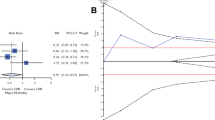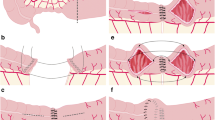Abstract
Background
The study of long-term complications after pancreaticoduodenectomy (PD) for malignant disease has been problematic given the paucity of patients with long-term survival after diagnosis and surgical resection. We therefore studied patients who were surgically treated with a PD for a benign diagnosis to evaluate long-term anastomotic durability.
Methods
A retrospective analysis of 122 patients who had PD performed in the interval 1993–2003 inclusive for benign pancreatic diseases was undertaken. Long-term morbidity and mortality (specifically biliary, pancreaticojejunostomy [PJ], and gastrojejunostomy [GJ] strictures) were evaluated.
Results
Gender was equally represented with 53% female and 47% male. The median age at surgery was 55 years (range 15–81 years). The three most frequent diagnoses were chronic pancreatitis (40%), intraductal papillary mucinous neoplasm (16%), and cystic neoplasms (9%). Median follow-up in the 95 patients alive at last follow-up was 4.1 years (10 days–12.6 years). The 5- and 10-year survival rates were 83% (76, 91%) and 62% (49%, 78%), respectively. The observed survival was significantly lower than the expected survival in an age- and gender-matched U.S. white population, p < 0.001 (one-sample log-rank test). The 5- and 10-year cumulative probability of biliary stricture was 8% (2%, 14%) and 13% (4%, 22%), respectively. For pancreatic strictures the 5- and 10-year rates were 5% (0%, 9%) and 5% (0%, 9%), respectively. No GJ strictures were noted. The management of biliary strictures was primarily with dilatation and stent (78%) and less commonly operative intervention (22%). Pancreatic strictures required surgery alone (25%), surgery followed by endoscopic intervention (25%), or endoscopic therapy alone (50%).
Conclusion
Intervention for anastomotic strictures after pancreaticoduodenectomy is uncommon. Biliary strictures can usually be treated nonoperatively with dilation and stent. Our study likely underestimates the incidence of stricture formation. Prospective imaging studies may be warranted for a more accurate assessment of the rate of long-term anastomotic complications.





Similar content being viewed by others
Abbreviations
- CT:
-
computed tomography
- ERCP:
-
endoscopic retrograde cholangiopancreatography
- F:
-
female
- IR:
-
interventional radiology
- IPMN:
-
intraductal papillary mucinous neoplasm
- GJ:
-
gastrojejunostomy
- M:
-
male
- MCN:
-
mucinous cystic neoplasms
- MRCP:
-
magnetic resonance cholangiopancreatography
- PD:
-
pancreaticoduodenectomy
- PJ:
-
pancreaticojejunostomy
- PPPD:
-
pylorus preserving pancreaticoduodenectomy
- PTC:
-
percutaneous transhepatic cholangiogram
- SD:
-
standard deviation
References
Birkmeyer JD, Warshaw AL, Finlayson SRG, Grove MR, Tosteson AN. Relationship between hospital volume and late survival after pancreaticoduodectomy. Surgery 1999;126:178–183.
Ho V, Heslin MJ. Effect of hospital volume and experience on in-hospital mortality for pancreaticoduodenectomy. Ann Surg 2003;237:509–514.
Balcom JH, Rattner DW, Warshaw AL, Chang Y, Fernandez-del Castillo C. Ten-year experience with 733 pancreatic resections: changing indications, older patients, and decreasing length of hospitalization. Arch Surg 2001;136:391–398.
Abraham SC, Wilentz RE, Yeo CJ, Sohn TA, Cameron JL, Boitnott JK, Hruban RH. Pancreaticoduodenectomy (Whipple resections) in patients without malignancy: are they all ‘chronic pancreatitis’? Am J Surg Pathol 2003;27:110–120.
House MG, Cameron JL, Schulick RD, Campbell KA, Sauter PK, Coleman J, Lillemoe KD, Yeo CJ. Incidence and outcome of biliary strictures after pancreaticoduodenectomy. Ann Surg 2006;243:571–576.
Yi NJ, Suh KS, Cho JY, Kwon CH, Lee KU. In adult-to-adult living donor liver transplantation hepaticojejunostomy shows a better long-term outcome than duct-to-duct anastomosis. Transpl Int 2005;18:1240–1247.
Graziadei IW, Schwaighofer H, Koch R, Nachbaur K, Koenigsrainer A, Margreiter R, Vogel W. Long-term outcome of endoscopic treatment of biliary strictures after liver transplantation. Liver Transpl 2006;12:718–725.
Alazmi WM, Fogel EL, Watkins JL, McHenry L, Tector JA, Fridell J, Mosler P, Sherman S, Lehman GA. Recurrence rate of anastomotic biliary strictures in patients who have had previous successful endoscopic therapy for anastomotic narrowing after orthotopic liver transplantation. Endoscopy 2006;38:571–574.
Ammori BJ, Joseph S, Attia M, Lodge JP. Biliary strictures complicating pancreaticoduodenectomy. Int J Pancreatol 2000;28:15–21.
Moore AV, Illescas FF, Mills SR, Wertman DE, Heaston DK, Newman GE, Zuger JH, Salmon RB, Dunnick NR. Percutaneous dilation of benign biliary strictures. Radiology 1987;163:625–628.
Vos PM, van Beek EF, Smits NJ, Rauws EA, Gouma DJ, Reeders JW. Percutaneous balloon dilatation for benign hepaticojejunostomy strictures. Abdom Imaging 2000;25:134–138.
Gervais DA, Fernandez-del Castillo C, O’Neill MJ, Hahn PF, Mueller PR. Complications after pancreatoduodenectomy: imaging and imaging-guided interventional procedures. Radiographics 2001;21:673–690.
Schumacher B, Othman T, Jansen M, Preiss C, Neuhaus H. Long-term follow-up of percutaneous transhepatic therapy (PTT) in patients with definite benign anastomotic strictures after hepaticojejunostomy. Endoscopy 2001;33:409–415.
Born P, Rosch T, Bruhl K, Sandschin W, Allescher HD, Frimberger E, Classen M. Long-term results of endoscopic and percutaneous transhepatic treatment of benign biliary strictures. Endoscopy 1999;31:725–731.
Schnelldorfer T, Ware AL, Smyrk TC, Zhang L, Qin R, Gullerud RE, Sarr MG, Donohue JH, Nagorney DM, Farnell MB. Long-term survival of surgically treated pancreatic adenocarcinoma: the unique features. Gastroenterology 2007;132:A871–A872.
Bames S, Lillemoe K, Kaufman H, Sauter P, Yeo C, Talamini M, Pitt H, Cameron J. Pancreaticoduodenectomy for benign disease. Am J Surg 1996;171:131–134.
Cameron JL, Riall TS, Coleman J, Belcher KA. One thousand consecutive pancreaticoduodenectomies. Ann Surg 2006;244:10–15.
Reid-Lombardo KM, Farnell MB, Crippa S, Barnett M, Maupin G, Bassi C, Traverso LW; Members of the Pancreatic Anastomotic Leak Study Group. Pancreatic anastomotic leakage after pancreaticoduodenectomy in 1,507 patients: a report from the Pancreatic Anastomotic Leak Study Group. J Gastrointest Surg 2007; in press.
Gordon TA, Burleyson GP, Tielsch JM, Cameron JL. The effects of regionalization on cost and outcome for one general high-risk surgical procedure. Ann Surg 1995;221:43–49.
Porter GA, Pisters PW, Mansyur C, Bisanz A, Reyna K, Stanford P, Lee JE, Evans DB. Cost and utilization impact of a clinical pathway for patients undergoing pancreaticoduodenectomy. Ann Surg Oncol 2000;7:484–489.
Sakorafas GH, Farnell MB, Nagorney DM, Sarr MG, Rowland CM. Pancreatoduodenectomy for chronic pancreatitis: long-term results in 105 patients. Arch Surg 2000;135:517–523.
Buhler L, Schmidlin F, de Perrot M, Borst F, Mentha G, Morel P. Long-term results after surgical management of chronic pancreatitis. Hepatogastroenterology 1999;46:1986–1989.
Martin RF, Rossi RL, Leslie KA. Long-term results of pylorus-preserving pancreatoduodenectomy for chronic pancreatitis. Arch Surg 1996;131:247–252.
Jimenez RE, Fernandez-del Castillo C, Rattner DW, Chang Y, Warshaw AL. Outcomes of pancreaticoduodenectomy with pylorus preservation or with antrectomy in the treatment of chronic pancreatitis. Ann Surg 2000;231:293–300.
Author information
Authors and Affiliations
Corresponding author
Rights and permissions
About this article
Cite this article
Reid-Lombardo, K.M., Ramos-De la Medina, A., Thomsen, K. et al. Long-term Anastomotic Complications After Pancreaticoduodenectomy for Benign Diseases. J Gastrointest Surg 11, 1704–1711 (2007). https://doi.org/10.1007/s11605-007-0369-7
Received:
Accepted:
Published:
Issue Date:
DOI: https://doi.org/10.1007/s11605-007-0369-7




